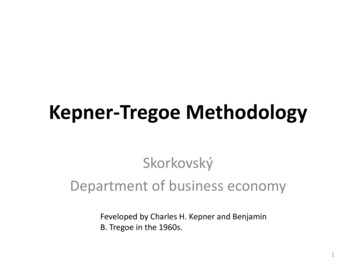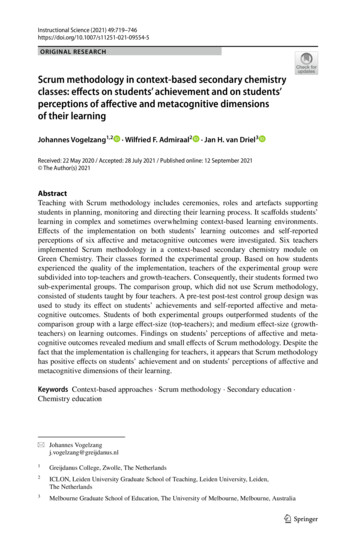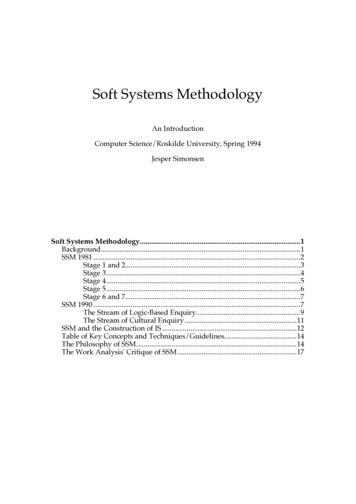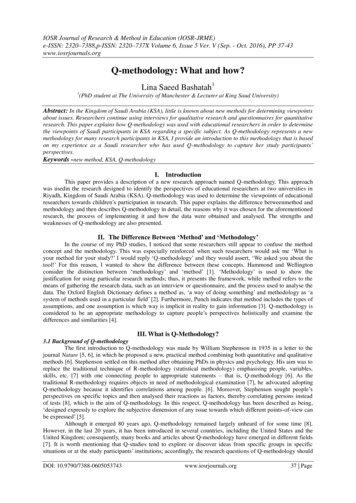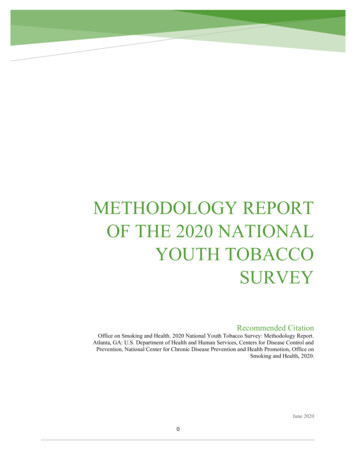
Transcription
METHODOLOGY REPORTOF THE 2020 NATIONALYOUTH TOBACCOSURVEYRecommended CitationOffice on Smoking and Health. 2020 National Youth Tobacco Survey: Methodology Report.Atlanta, GA: U.S. Department of Health and Human Services, Centers for Disease Control andPrevention, National Center for Chronic Disease Prevention and Health Promotion, Office onSmoking and Health, 2020.June 20200
For questions about this report, please email Sean Hu at fik4@cdc.govPrepared for Centers for Disease Control and PreventionPrepared by ICF, Rockville, MarylandCenters for Disease Control and PreventionOffice on Smoking and HealthAtlanta, GAJune 20200
TABLE OF CONTENTSCHAPTER 1—NYTS SAMPLING DESIGN . 11.1 OVERVIEW OF THE NATIONAL YOUTH TOBACCO SURVEY (NYTS) . 11.2 OVERVIEW OF THE 2020 NYTS METHODOLOGY . 1CHAPTER 2—NYTS SAMPLING METHODS . 32.1 SAMPLE DESIGN . 32.2 SAMPLING FRAME . 42.3 SAMPLING UNITS AND MEASURE OF SIZE . 52.4 PROJECTED SAMPLE SIZES. 62.5 FORMING SAMPLING UNITS . 72.6 STRATIFICATION . 82.7 SAMPLE ALLOCATION AND SELECTION . 92.8 SAMPLE SIZES ATTAINED IN THE SURVEY .102.9 SAMPLE VALIDATION .12CHAPTER 3—NYTS DATA COLLECTION AND PROCESSING . 133.1 SURVEY INSTRUMENT .133.2 EXTERNAL REVIEW AND APPROVALS .143.3 DATA COLLECTION STAFFING .143.4 RECRUITMENT PROCEDURES .153.5 SURVEY ADMINISTRATION .153.6 WEB-BASED DATA COLLECTION MANAGEMENT APPLICATION (DCMA) .163.7 DATA SYNCING AND RECORDING.163.8 PARTICIPATION RATES .173.9 DATA MANAGEMENT .17CHAPTER 4—WEIGHTING OF NYTS RESPONSE DATA . 194.1 SAMPLING WEIGHTS .194.2 NONRESPONSE ADJUSTMENTS .224.3 POST-STRATIFICATION AND TRIMMING .254.4 ESTIMATORS AND VARIANCE ESTIMATION .30APPENDICESA. IMPLICATIONS OF COVID-19 CLOSURES FOR WEIGHTING THE 2020 NYTS DATAB. QUESTIONNAIREC. STUDENT WEIGHT DETAILD. COMMON CORE OF DATA RACE/ETHNICITY DEFINITIONS
CHAPTER 1—NYTS SAMPLING DESIGN1.1OVERVIEW OF THE NATIONAL YOUTH TOBACCO SURVEY (NYTS)The National Youth Tobacco Survey (NYTS) was developed to provide the data necessary tosupport the design, implementation, and evaluation of state and national tobacco prevention andcontrol programs (TCPs).1,2 Tobacco-related indicators included in the NYTS are: tobacco use (ecigarettes, cigarettes, cigars, smokeless tobacco, hookahs, roll-your-own cigarettes, pipes, snus,dissolvable tobacco, bidis, and heated tobacco products); exposure to secondhand smoke and ecigarette aerosol; smoking cessation; minors’ ability to purchase or obtain tobacco products;knowledge and attitudes about tobacco; and familiarity with pro-tobacco and anti-tobacco mediamessages. Estimates based on NYTS data also serve as essential benchmarks against which TCPscan assess the extent of youth tobacco use. The NYTS provides multiple measures and data for sixof the 20 tobacco-related Healthy People 2020 objectives (USDHHS, 2010): TU-2, TU-3, TU-7,TU-11, TU-18 and TU-19. Similarly, future cycles of NYTS will provide measures and data forHealthy People 2030 objectives (USDHHS, 2020): TU-3, TU4, TU5, TU-6, and TU7.First conducted during fall 1999 and again during the springs of 2000, 2002, 2004, 2006, and 2009,then annually starting in 2011, the NYTS provides data that are representative of all middle schooland high school students in the 50 states and the District of Columbia. Beginning in 2011, theCenters for Disease Control and Prevention (CDC) and the Food and Drug Administration (FDA)collaborated to administer the NYTS.1.2OVERVIEW OF THE 2020 NYTS METHODOLOGYThe 2020 NYTS employed a stratified, three-stage cluster sample design to produce a nationallyrepresentative sample of middle school and high school students in the United States. Samplingprocedures were probabilistic and conducted without replacement at all stages and entailedselection of: 1) Primary Sampling Units (PSUs) (defined as a county, or a group of small counties,or part of a very large county) within each stratum; 2) Secondary Sampling Units (SSUs), (definedas schools or linked schools) within each selected PSU; and 3) students within each selectedschool.After being conducted via paper and pencil questionnaires since its inception in 1999, the NYTSbegan using electronic data collection methods starting in 2019. The 2020 cycle again wasconducted electronically. Participants were provided with a tablet to complete the survey; datawere collected offline using a programmed survey application; a single class period ofapproximately 35-45 minutes was allotted to complete the survey. Survey administrators laterestablished secure WiFi connections to sync all locally stored tablet data to a central repository viaencrypted transmissions. Absent students and whole classes unavailable on the day of survey1Centers for Disease Control and Prevention. (CDC) (2014). Best Practices for comprehensive tobacco control programs-2014. Atlanta, GA: USDepartment of Health and Human Services, Public Health Service, CDC.2Centers for Disease Control and Prevention. Surveillance and Evaluation Data Resources for Comprehensive Tobacco Control Programs.Atlanta, GA: Centers for Disease Control and Prevention, National Center for Chronic Disease Prevention and Health Promotion, Office onSmoking and Health; 2014.1
administration could participate in make-up surveys using a web-based version of thequestionnaire programmed to mimic the tablet-based application.Participation in the NYTS was voluntary at both the school and student levels. At the student level,participation was anonymous. CDC’s Institutional Review Board (IRB) requires that parents begiven the opportunity to opt their student out of participating in the survey. Schools used eitherpassive or active permission forms at their discretion.Survey administration initiated on January 16, 2020 and was expected to extend until May 15,2020. However, data collection was ended early on March 16, 2020 due to widespread schoolclosures as a result of the COVID-19 pandemic. The final sample consisted of 361 schools, ofwhich 180 participated prior to school closures, yielding a school participation rate of 49.9%. Atotal of 14,531 student questionnaires were completed out of a sample of 16,634 students, yieldinga student participation rate of 87.4%. The overall participation rate, defined as the product of theschool-level and student-level participation rates, was 43.6%.A weighting factor was applied to each student record to adjust for nonresponse and for varyingprobabilities of selection. Weights were adjusted to ensure that the weighted proportions ofstudents in each grade matched national population proportions. Appendix A describes theevaluation undertaken to determine the feasibility of weighting the 2020 NYTS given the overallparticipation rate was lower than historic levels. The evaluation showed that the sample of 14,531participating students from 180 schools was representative in terms of small potential bias andvariances. The sample then was weighted with the procedures described in this report.The remainder of this report provides detailed information on the methodology used in the 2020NYTS sample selection (Chapter 2), data collection (Chapter 3), and weighting of student responsedata (Chapter 4).2
CHAPTER 2—NYTS SAMPLING METHODS2.1SAMPLE DESIGNThe objective of the NYTS sampling design was to support estimation of tobacco-relatedknowledge, attitudes, and behaviors in a national population of public and private school studentsenrolled in grades 6 through 12 in the United States. More specifically, the study was designed toproduce national estimates at a 95% confidence level by school level (middle school and highschool), by grade (6, 7, 8, 9, 10, 11, and 12), by sex (male and female), and by race/ethnicity (nonHispanic white, non-Hispanic black, and Hispanic). Additional estimates also were supported forsubgroups defined by grade, by sex, and by race/ethnicity, each within school level domain;however, precision levels varied according to differences in subpopulation sizes.The universe for the study consisted of all public and private school students enrolled in regularmiddle schools and high schools in grades 6 through 12 in the 50 U.S. states and the District ofColumbia. Alternative schools, special education schools, Department of Defense-operatedschools, Bureau of Indian Affairs schools, vocational schools that serve only pull-outpopulations, and students enrolled in regular schools unable to complete the questionnairewithout special assistance were excluded. The NYTS employed a repeat cross-sectional design.The sample was a stratified, three-stage cluster sample. PSUs were stratified by racial/ethnic statusand urban versus non-urban. PSUs were classified as "urban" if they were in one of the 54 largestMetropolitan Statistical Areas (MSAs) in the United States; otherwise, they were classified as"non-urban." Within each stratum, PSUs, defined as a county, a portion of a county, or a group ofcounties, were chosen without replacement. Table 2.1 presents key sampling design features.Table 2.1SamplingStage1Key Sampling Design FeaturesSampling UnitsStratificationUrban vs. Non-urban(2 strata);PSUs: Counties,portions of a county, or Minority concentrationgroups of counties(8 strata)2Schools3Classes/studentsSmall, medium andlarge;High school vs. middleschool3Measure of Size Designed Sample Size(MOS)Aggregateschool size intarget gradesAggregateeligibleenrollment100 Counties, portionsof a county, or groupsof counties320 SSUs (school)selections: 240 largeschools (2 per PSU),50 medium schools and30 small schools2 classes per grade inhalf of large schools ;1class per gradeotherwise
As described in Section 1.2, the first stage of sampling selected Primary Sampling Units (PSUs)within each stratum for a total of 100 sample PSUs. At the second sampling stage, 240 largeschools, or SSUs, were selected from the sample PSUs. Two large schools were selected per samplePSU, one per level (middle or high). An additional large school for each level was selected in asubsample of 20 PSUs. An additional 50 medium SSUs and 30 small SSUs were selected fromsubsample PSUs, for a total of 320 sample SSUs (320 240 50 30). The PSU subsamples wereselected with simple random sampling, and the schools were drawn with probability proportionalto the total number of eligible students enrolled in a school.Depending on the average design effects, target subgroup sample sizes were between 1,200 and1,700. The NYTS design has experienced lower design effects with less oversampling over thelast few cycles (due to proportional allocation and enrollment size measures). Compared toprevious cycles, the NYTS sampling design has had both lower effects on unequal weighting andsmaller clustering effects. These factors lead to lower design effects, particularly for subgroups.Smaller design effects have, in turn, led to smaller variances and improved precision.An appropriate sample size can enable generation of estimates with the required precision by gradeas well as by sex and school level. Therefore, the precision requirements generally focused onracial/ethnic subgroups within school level. The targets of n 850 students per minority group byschool level (1,700 total per group) correspond to prevalence estimates within /- 5% forconfidence intervals at 95% confidence for all key racial/ethnic subgroups when broken down byschool level.Sample sizes for Hispanics, a subgroup that has steadily increased in representation, meet even themore conservative targets. Sample sizes for blacks, which bordered on but did not reach theoriginal targets in 2020 when broken down by school level, still lead to precise subgroup estimates.These conservative targets reflected expected design effects that were larger than those observedfor the NYTS.These are evidenced in Tables 4-4 to 4-7 in Chapter 4, which show that for all key racial/ethnicsubgroups, prevalence estimates were within /- 5% for confidence intervals at 95% confidence(i.e., standard errors were less than 2.5%), as in the original design requirements. Standard errorswere less than 2.5% for all estimates for Hispanic and black students at the middle school and highschool level with one marginal exception.32.2SAMPLING FRAMEAs in previous cycles, the 2020 NYTS sample was based on a comprehensive sampling framefrom multiple data sources to increase the coverage of schools nationally. The frame combineddata files obtained from MDR Inc. (Market Data Retrieval Inc.) and from the National Center forEducation Statistics (NCES). The MDR frame contained school information that includedenrollments, grades, race/ethnicity distributions within the school, district and county information,and other contact information for public and non-public schools across the nation. The NCES3The marginal exception was for the ever use prevalence of electronic cigarettes for Hispanic high-school studentswhere the standard error reached 2.54%.4
frame sources included the Common Core of Data for public schools and the Private School Surveyfor non-public schools. This dual-source frame build method was piloted first in 2014 to build theframe for the NYTS.4 Including schools sourced from the two NCES files resulted in a coverageincrease among all public and non-public high schools of 6.6%. Most of the added schools weresmaller schools. Efforts were made to ensure that each school was represented only once in thefinal sampling frame, even if the school showed up in both source files.Certain schools were removed from the frame prior to drawing the sample following a stepwiseprocess. The first step excluded non-eligible schools by category to remove schools such asDepartment of Defense schools, vocational schools, and adult education schools. This resulted inthe exclusion of 3.8% of schools (2.8% of public schools and 8.0% of private schools) and 1.1%of students. Lastly, schools were removed that had fewer than 40 students enrolled across eligiblegrades, resulting in the exclusion of 20.6% of schools (13.3% public and 42.8% private) whichwere eligible after the other exclusions. This exclusion of schools with fewer than 40 students ledto the exclusion of only 1.06% of students of those in eligible schools.2.3SAMPLING UNITS AND MEASURE OF SIZEA three-stage cluster sample design was used to produce a nationally representative sample ofstudents in grades 6–12 attending public and private schools. The first-stage sampling frameconsisted of PSUs made up of counties, groups of smaller, adjacent counties, or parts of largercounties. For the second stage of sampling, secondary sampling units (SSUs) were defined as aphysical school that can supply a full complement of students in grades 6 through 8 (middle school)or 9 through 12 (high school) or a school created by linking component physical schools togetherto provide all grades for the level.Schools were stratified into small, medium, and large schools based on their ability to support lessthan one, one or two class selections per grade. Small SSUs contained fewer than 28 students atany grade level, and large SSUs contained at least 56 students at each grade level. The remainingschools were classified as medium sized.The sampling stages may be summarized as follows: Selection of PSUs—One hundred PSUs (from approximately 1,258 PSUs) were selectedfrom 16 strata with probability proportional to the total number of eligible studentsenrolled in all eligible schools located within a PSU. Selection of schools—At the second sampling stage, 240 large schools, or SSUs, wereselected from the sample PSUs. Additionally, as described in Section 2.1, we selected 30small schools and 50 medium schools, resulting in a total of 320 sample SSUs (320 240 50 30). Selection of students—Students were selected via whole classes whereby all studentsenrolled in any one selected class were chosen for participation. Classes were selectedRedesigning National School Surveys: Coverage and Stratification Improvement using Multiple Datasets. WilliamRobb, Kate Flint, Alice Roberts, Ronaldo Iachan, ICF International, FEDCASIC, March 201445
from course schedules provided by each school so that all eligible students had only asingle chance of selection.The sampling approach utilized probability proportional to size (PPS) sampling methods with themeasure of size (MOS) defined as the count of final-stage sampling units, students in intactclassrooms. Coupled with the selection of a fixed number of units, the design resulted in an equalprobability of selection for all members of the universe (i.e., a self-weighting sample). Theseconditions were approximated for the NYTS resulting in the attainment of a roughly self-weightingsample.The MOS also was used to compute stratum sizes and PSU sizes. By assigning an aggregatemeasure of size to the PSU, the sample allocated to the PSU was in proportion to the studentpopulation.The third, and final, sampling stage selected classes within each grade of a sample SSU. Weselected two classes per grade in large schools and one class per grade in the remaining schools.The threshold for double class sampling was based on a simulation study to ensure that the requirednumbers of minority students were achieved per school level.All students in a selected class then were selected for the survey.2.4PROJECTED SAMPLE SIZESThis section describes the planned sample sizes developed by the design, while Section 2.8discusses the actual sample sizes attained in the survey. The NYTS sample size calculations werebased on the following assumptions: The main structure of the sampling design was consistent with the design used to draw thesample for prior cycles of the NYTS.The design included the selection of two large SSUs within each sample PSU, and anadditional 40 large, 50 medium and 30 small schools from subsample PSUs.Across 15 previous cycles of the NYTS that had concluded at the time of the 2020 NYTS design,school participation had averaged 82.9%. Student participation had averaged 89.7%. The combinedresponse rate (student x school) averaged 74.3%. Historical participation rates at both school andstudent levels guided the sampling design and sample sizes. In calculating the sample sizes for the2020 NYTS, we made our approach more robust by assuming a conservative combined rate (studentx school) of 63.8%, substantially lower than the historical overall response rate. These numbers arecloser to the more recent experience at both levels. Table 2.2 presents a detailed derivation of thesample sizes planned for the 2020 NYTS based on these assumptions.6
Table 2.2Planned Sample Sizes for the 2020 NYTSPSUSize# ofSSUs100Large HS120Large MS25(subsample)15(subsample)Large TotalMedium HSMedium MSMedium TotalSmall HSSmall MSSmall TotalOverall Total120240252550151530320# ofClassesperSchool# ofStudentsperClass# of SampledStudentsprior toAttritionDoubleclasses: 60Singleclasses: 60Doubleclasses: 60Singleclasses:6082512,000# ofParticipatingStudentsBased on63.75%Response mber ofSchoolsSampledOne-hundred PSUs were selected, with two large SSUs (“full” schools) selected from each PSUand one additional large SSU per level selected from 20 subsampled PSUs for a total of 240 largeSSUs. The estimated sample yield from these large schools was 31,500 students before school andstudent non-response, leading to an expected total 20,081 participating students in large schoolsafter accounting for non-response.Additionally, 50 medium SSUs from a subsample of 25 PSUs were selected, yielding an expectedsample size of 4,375 students. Finally, to provide adequate coverage of students in small schools(those with an enrollment of less than 28 students in any grade) 30 small SSUs from a subsampleof 15 PSUs were selected. The expected yield was 2,625 students from small schools. In total, thenumber of participating students in large, medium, and small schools was 24,544.For the 2020 NYTS, within each school, one class was selected from each grade to participate inthe survey except in a portion of large schools where we implemented double class selection forhalf of large schools (randomly selected) to ensure sufficient student yields. Note that the set ofthe latter schools defined for double class sampling is necessarily a subset of the large schools thatcan support such double class sampling.2.5FORMING SAMPLING UNITS2.5.1 Forming primary sampling units (PSUs)In defining PSUs, several issues were considered:7
Each PSU should be large enough to contain the requisite numbers of schools and studentsby grade, and small enough so as not to be selected with near certainty.Each PSU should be compact geographically so that field staff could go from school toschool easily.PSUs should be consistent with school and school district definitions (i.e., should not crossor split districts).PSUs are defined to contain at least four middle and five high schools.Generally, counties were equivalent to PSUs, with two exceptions: Low population counties were combined to provide sufficient numbers of schools andstudents. High population counties were divided into multiple PSUs so that the resulting PSUs wouldnot be selected with certainty.The PSU frame was screened for PSUs that no longer met the above criteria. The frame wasadjusted by recombining small counties/PSUs as necessary to ensure sufficient size whilemaintaining compactness. Near-certainty PSUs were split using an automated procedure built intothe sampling program.2.5.2 Forming secondary sampling units (SSUs)Single schools represented their own SSU if they had students in each of grades 6 through 8 or ingrades 9 through 12. Schools that did not have all eligible grades for the level were groupedtogether to form an SSU. Linked schools were treated as single schools during sampling. Forexample, a school containing 6th grade but not 7th and 8th grades can be linked with another schoolwith the latter grades at the middle school level. At the high school level, a school that containsonly 9th but not the other high school grades can be linked with another containing the latter grades.2.6STRATIFICATIONThe PSUs were organized into 16 strata, based on urban/non-urban location and proportionminority enrollment. If the percentage of Hispanic students in the PSU exceeded the percentage of non-Hispanicblack students, then the PSU was classified as Hispanic. Otherwise it was classified as nonHispanic black.If the PSU was within one of the 54 largest MSAs in the United States, it was classified as“urban,” otherwise it was classified as “non-urban.”Hispanic urban and Hispanic non-urban PSUs were classified into four density groupingsdepending upon the percentages of Hispanic students in the PSU.Non-Hispanic black urban and non-Hispanic black non-urban PSUs were also classifiedinto four groupings depending upon the percentages of black students in the PSU.8
The density grouping bounds were computed using an optimization algorithm5 that is refreshedeach cycle to reflect changes in the racial/ethnic distribution of the student population. Theboundaries or cutoffs changed as the frequency distribution (“f”) for the racial groupings changedfrom one survey cycle to the next. Table 2.3 presents the stratum boundaries used in the 2020NYTS.Table 2.3 Stratum Boundaries: Minority Percentage oup12341234BoundsUrban0%-26% 26%-40% 40%-54% 54%-100%0%-26% 26%-42% 42%-58% 58%-100%Non-urban0%-20% 20%-34% 34%-54% 54%-100%0%-24% 24%-48% 48%-68% 68%-100%As described earlier, SSUs were stratified into three sizes for small, medium, and large schools.2.7SAMPLE ALLOCATION AND SELECTIONPSUs were initially allocated to strata proportional to student enrollment. For this cycle, a nearlyproportional PSU allocation was achieved, resulting in gains in sampling efficiency. Table 2.4shows the actual allocation of the PSU sample to the 16 strata defined by minority density andurban status, alongside a proportional allocation. The initial proportional allocation was slightlymodified to ensure that all strata contained at least two PSUs to facilitate accurate varianceestimation.5The cumulative square root of “f” method developed by Dalenius and Hodges.9
Table 2.4First-Stage Strata and Frame PSU ,931,0265,092,3951,462,4611,001,750676,887Number ofSamplePSUs(Revised)852295421198716543The sample was selected with PPS methods at the first and second stages. With PPS sampling, theselection probability for each PSU is proportional to the PSU’s measure of size. Systematicsampling procedures were applied to the stratified frame to select a PPS sample of PSUs:2.8 Selected 100 PSUs with a systematic random sampling within each stratum. The methodapplied within each stratum was a sampling interval computed as the sum of the measuresof size for the PSUs in the stratum, divided by the number of PSUs to be selected in thestratum. Subsampled PSUs for additional large schools (20 PSUs), small school (15 PSUs) andmedium school (25 PSUs) sampling of two schools per level in each subsample PSU.SAMPLE SIZES ATTAINED IN THE SURVEYThe 2020 NYTS attained the target sample sizes in the key analytic subgroups of interest. Tables2.5a–d show the number of participating students in subgroups defined by gender, grade, andrace/ethnicity. Table 2.5d, about the race/ethnicity distribution, is presented in two different ways:1) using the original variable allowing for multiple races and including missing data, and 2) usingthe variable whereby all respondents are categorized into a single race/ethnic group. The sampleled to 4,355 Hispanic students and 1,602 black students using the single-race variable.10
Table 2.5aSubgroup Sample Sizes: Number of Participating StudentsWhat is your sex?Q2Frequency5Displayed, not answered39Male7153Female7339Table 14531CumulativePercent0.2749.49100.00Subgroup Sample Sizes: Number of Participating StudentsWhat grade are you in?Q3Displayed, not answered56th7th8th9th10th11th12thUngraded or other 7.4399.86100.00Table 2.5c Subgroup Sample Sizes: Number of Participating StudentsRECODE: Race/Eth - mult grpRACE M Missing NH-WhiteNH-BlackHispanicNH-AsianNH-AI/ANNH NHOPIMultiple cent2.5147.3957.9187.8893.5394.9395.31100.00Note: This variable is named race m (respondents could select more than one race) in the public use data set. Therace/ethnicity categories are Hispanic, non-Hispanic (NH) white, non-Hispanic black, non-Hispanic Asian, nonHispanic American Indian or Alaskan Native (AIAN), and non-Hispanic Native Hawaiian or Pacific Islander(NHOPI). Please see the detailed definitions of race/ethnicity at Appendix D.11
Table 2.5dSubgroup Sample Sizes: Number of Participating StudentsRECODE: Race/Eth - no mult grpRACE ent Missing I540.37145
NYTS SAMPLING DESIGN . 1.1 O. VERVIEW OF THE . N. ATIONAL . Y. OUTH . T. OBACCO . S. URVEY (NYTS) The National Youth Tobacco Survey (NYTS) was developed to provide the data necessary to support the design, implementation, and evaluation of state and national tobacco prevention and control programs (TCPs). 1,2




